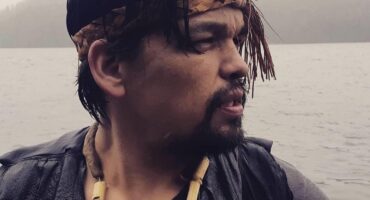ƛayaḥuʔałs n̓ačuuł siiw̓a. ʔukłaas n̓aasʔałuk. histaqšiƛs ʕaḥuusʔatḥ ʔuḥʔiiš qiłcmaʔatḥ
Greetings to all of you. My name is n̓aasʔałuk. I come from Ahousaht and Keltsmaht territory.
nuučaan̓uł (Nuu-chah-nulth) territory spans across the western coast of Vancouver Island and the northwestern tip of Washington State. As an oceanic/coastal people, one of our our main unique characteristic exists within the ancient Whaling rituals and practices of our people. Our rich and deeply-rooted history still exists today through stories, songs and language.
Over the past six years I have been actively learning and teaching my language. For fifteen years I have been reconnecting with my traditional territory, plants, medicines, hunting and, harvesting. Our collective experience with Developing Fluency has been accompanied by several challenging factors:
- Elder/Speaker accessibility and capacity
- Most of our native speakers learned at birth in a fluent environment. Tailoring their language comprehension with contemporary teaching techniques/methods has taken more time than we have available.
- Learning Approaches specific to our way of life
- In order to revitalize our language we have often had to rely upon introduced learning spaces and platforms (classrooms, written phonetics, audio/video/online resources, etc.). It has proven difficult to contain our language into these introduced modalities. Our language thrives in our oceanic, coastal, and forested environments but is limited in introduced spaces. This factor often limits the extent of fluency for our learners that solely learn our language in introduced environments (with introduced words/concepts).
Background
n̓aasʔałuk (John Rampanen) is a Sessional Instructor with the University of Victoria and a consultant specializing in indigenous history, culture, spirituality and medicines. He lives remotely on the western coast of Vancouver Island within his traditional territory.<br /> The organization offers a supportive environment that attempts to duplicate the community spirit and culture of the Inuit homelands by exercising traditional Inuit values.

- Limitations to learning environments
- Stemming further from the aforementioned challenge with learning approaches, we are also challenged with limited space for suitable learning environments that are dedicated to language revitalization, culturally relevant and land/ocean-based.
My language learning accelerated through academic course offerings specifically focusing upon indigenous language revitalization. (University of Victoria). However, as a student, I quickly realized that the academic approach to language revitalization was not effective for many of our learners. I shifted my focus toward re-indigenizing the curriculum being offered and piloted an immersive, land-based course. Since then, I have continued to offer language learning opportunities that move beyond the classroom and into our world.
Today, I have returned to live on my traditional territory with my wife and children. As a family, we learn, share and grow our culture and language on the land. Our hopes are that our children and grandchildren will learn our language in a culturally-fluent manner that is reconnected to our lands and waters. Ultimately, we plan to develop a series of longhouses that will support additional families and communities with their efforts to revitalize language.
I recommend that beginner language learners and advanced learners that wish to incorporate a land-based approach to their immersion initiatives begin with developing a deeper connection and understanding of the local environment. Plants, medicines, animals and birds forge deeply rooted relationships and communication that remind us of our role/purpose and origins of language. Also, natural rhythms and flow such as sunrise/set, lunar patterns, weather and tide, etc. all play integral roles within our respective indigenous languages. These concepts and elements can be challenging to learn/teach in a structured classroom environment. Rather, learners should be equipped with land based language as a preparatory step toward (re)developing closer connections with the natural world. We have achieved this through the development of an interactive board game that provides an entertaining and educational exploration of the thirteen moon calendar of nuuchahnulth ancestors. This learning resource offers language learning and cultural fluency in a household and/or class environment. Learners that become familiar with key concepts relating to harvestable resources, seasons, weather, environments, etc. acquire skills and language that are transferable to real world learning opportunities.



